
Germany’s Only Travel Guide You Need For A Great Trip in 11 Easy Steps
- Destinations Europe
Cruisit Team
- July 7, 2022
- 0
- 4768
- 94 minutes read
Germany’s Background
Germanic peoples are thought to have existed as early as 800 BC in the northern and Celtics in the southern parts of what we now call Germany. Julius Caesar’s Gallic Wars in 50 BC brought the Romans into touch with both the Germanic and Celtic populations. Arminius, the Germanic chieftain who led three Roman legion bloodbaths, put an end to fierce territorial battles in what is now Hungary and Austria. However, like with many of their victories elsewhere, the Romans attempted to take the territory and maintained a border until the mid-300s AD. However, Roman contact was also the reason that Germanics of the period began to embrace so much of Roman culture and commerce as a result of open trading between the two nations. When the Roman Empire dissolved in the west in the late fifth century, the region was politically unstable, with tribes and other neighbors nabbing what was left of the Romans.
Years of power struggles and battles afflicted Germany until, in 1871, the majority of German states merged to form the Prussian-dominated German Empire. Following Hitler’s appointment as chancellor of Germany in 1933, following a string of election triumphs by the Nazi Party, came World War II, with Adolf Hitler discovering from one of his generals that no German defense was provided to the Russian attack at Eberswalde. The Soviet Army eventually took Berlin. On 15 April 1945, the Soviet Union launched a tremendous artillery bombardment, one of the greatest in history, on German positions west of the Oder. Hitler then admits to everyone in his underground bunker that the battle is over and that death is his last option after being invaded by the victorious Allied powers of the United States, United Kingdom, France, and the Soviet Union in 1945.
Following World War II, during the cold war, two German states were formed in 1949, the western Federal Republic of Germany and the eastern German Democratic Republic, which then ceased to exist and joined the FRG in 1990, marking the beginning of what we now know as Germany and one of the founding members of the European Union. Since then, Germany has spent a lot of money to bring Eastern productivity and salaries up to Western levels. Germany and ten other EU members established the euro, a unified European exchange currency, in January 1999.
Why was the European Union established? After WWII, several Western European countries strived for economic, social, and political ties in order to achieve economic growth and military security, as well as to promote a lasting reconciliation between France and Germany, and those two countries are pretty much Europe’s solid founders and economies. Germany, Europe’s largest economy and most populous country, continues to play an important role in the continent’s economic, political, and defense institutions. The most industrialised and populated country in Europe, renowned for its technical achievements, and the birthplace of some of Europe’s most acclaimed musicians, philosophers, and poets. Germany is the most populous country in Central Europe. It has significant financial, cultural, and political clout, and it is known for its precise engineering and high-tech goods. Despite its technical dominance, it manages to retain an old-world charm and “Gemutlichkeit” (coziness) or friendliness. It’s a beautiful area to visit, and most visitors find the natives to be quite friendly and ready to show off their country.
Few countries have had the same global effect as Germany, which gave us the Hansa, the Reformation, and, yes, Hitler and the Holocaust, but also the printing press, the vehicle, aspirin, and MP3 technology. It is the birthplace of Martin Luther, Albert Einstein, and Karl Marx, as well as Beethoven, the Brothers Grimm, and other historical figures. You can stand in a Roman amphitheater, sleep in a medieval castle, and stroll along relics of the Berlin Wall – the past is everywhere in Germany.
“A whirlwind of excitements, delights, and temptations as well as a grim history awaits you as you travel across Germany’s startling beauty, uplifting culture, big-city attractions, gorgeous palaces, and half-timbered villages.“
In cities where streets were planned out long before Columbus set sail, and castles that hover above beautiful, partially timbered villages where flower boxes protrude with crimson geraniums, you’ll find history. The big cities, such as Berlin, Munich, and Hamburg, come in more diversity than you can take in, but they all will dazzle you with a cultural spectrum ranging from art museums and high-brow opera to wicked cabaret and underground clubs. Wherever you go, Romanesque, Gothic, and Baroque masterpieces rub shoulders with modern masterworks like Daniel Libeskind, David Chipperfield, and Frank Gehry.
Europe’s heart is very much its heart. Germany has evolved into a tolerant society seeking compromise rather than conflict, despite, or maybe because of, its tragic recent history. People nowadays rush to it rather than away from it. One region of Germany is traditional, while another is trendy. An amalgamation of old medieval settlements and contemporary structures. It’s a mix of punk, formal, and lederhosen. It’s schnitzel, bratwurst, and kebab.
For the young and active, Berlin is the place to be. It is once again the world’s avant-garde capital, with a thriving artist and underground culture. However, there is more. Germany is a country of forests and rolling hills, with beautiful communities nestled among them. The Alps in the south provide an ideal setting for fairy-tale castles.
The way Germany’s environment developed is unquestionably artistic: the corrugated, dune-fringed coastlines of the north; the dark forests, seductive river valleys, and huge vineyards of the middle; and the Alps, sculpted into jagged magnificence by glaciers and the elements. All of them are components of a magnificent natural matrix that will undoubtedly put a strain on your camera batteries. Get off the freeway and into nature to take in the breathtaking scenery that makes each wonderful, slow, winding mile so special.
You can max out your speedometer on the autobahn or take a leisurely slow-paced boat along the Rhine, appreciating the beauty of vineyards, castles, and medieval hamlets, and perhaps pausing to sample one of the numerous white wines produced. Hamburg’s nightlife and music culture are vibrant in the north. Head to the Ruhr area for a peek at what made Germany famous, with its heavy industry and mining tradition. The famed labor and concentration camps, as well as Cold War ruins in the east, are more dismal sights. And if you become hungry after all that touring, German food is substantial and satisfying, with plenty of options.
Tasting Germany’s food and drinks will enrich your memories, as well as your stomach. You’ll immediately realize that local cuisine is far more than sausages and pretzels, schnitzel. A plethora of national and seasonal palate-teasers lies beyond the standards. Share the German fascination with white asparagus, chanterelle mushrooms, and game, in the spring, summer, and autumn respectively. Eat bratwurst and sauerkraut like the natives, and put on your lederhosen; it’s time to become German!
Given its size, the nation features numerous separate areas that are surprisingly diverse, making it a joy to explore. The north is notable for its hills and lengthy coastline along the Baltic Sea. Western Germany is a fantastic area to unwind and wander among the vineyards. Central Germany is known for its deep woods, ancient villages, and big cities that serve as financial hubs. Eastern Germany is home to Berlin, whereas Southern Germany borders the Alps and has some of Europe’s most magnificent scenery. Germany offers numerous interesting cities to visit, the most popular of which being Berlin, Munich, Frankfurt, and Hamburg.
Allow several days in each metropolis, but make time to explore the countryside and Germany’s beautiful, fairytale-like little villages as well. When most people think of Germany, they see castles. Many of them may be found along the “Romantic Road,” a renowned picturesque path that goes through many of the most well-known castles as well as a number of charming tiny villages. Neuschwanstein Castle is perhaps the most iconic castle along the itinerary.
Although Germany is not a cheap holiday destination, there are several strategies you may apply to save money. Booking your train tickets many weeks in advance will likely result in the most substantial cost reductions. This can lower your costs by up to half, but it will limit your options when traveling. There are also some inexpensive meal alternatives. Most major cities and towns, as well as many small communities, have street vendors. Most sell sausages, but occasionally you’ll discover more variety, and the prices are hard to beat.
If you’ve been tempted enough so far to explore Germany, read ahead for all the details you will need to not only enjoy your time and get to know what to do while in Germany, but also the travel budget, transportation options, and more.
- Berlin, the capital of undivided Germany and Europe’s bohemian capital, is home to underground cultures ranging from artists to punk bands to dance parties in disused warehouses. Stroll beneath the Brandenburger Tor and Unter der Linden, discover the remains of the Berlin Wall, and reflect on the atrocities of the Holocaust at the Holocaust Memorial.
- Visit Bavaria (or Bayern) during Oktoberfest in Munich (aka München), and don’t forget your lederhosen!
- Visit Neuschwanstein Castle, a fairy-tale creation in a spectacular setting.
- Take a boat along the Rhine (also known as the Rhein) or a ride through the Mosel Valley (also known as the Moseltal), which is filled with vineyards, quaint German villages, and castles.
- In Hamburg, see the Reeperbahn, where the Beatles began their career.
- Stroll through Dresden, the eastern Venice.
- Learn about Germany’s horrific past at Dachau Concentration Camp.
- Climb the Kölner Dom in Cologne (also known as Köln).
- Visit Bamberg, a World Heritage Site that is as medieval as it gets, or Rothenburg ob der Tauber, which is equally spectacular.
- On the German island of Rügen, take in some sea air.
- Explore Lake Constance.
- Hike in Hanover National Park of Berchtesgaden
- Look into Trier.
- Go to Dresden.
- Spend a day in Cologne.
- In Bamberg, go back in time.
- The German autobahns are famed for having no speed restrictions, but this is only partially true; most portions now have a speed limit, so keep an eye on the signs if you don’t want a fine! If you’re going to drive, remember that the left lane is the racing car lane on most highways, specifically the autobahn, so stay to the right if you want to be safe.
- Many museums are closed on Mondays, so check the schedule ahead of time. Or go on a Sunday, when admission to state-run museums is extremely inexpensive.
- Supermarkets are economical and an excellent way to eat well on a limited budget.
- In Germany, public transportation is excellent, with quick trains, buses, metros, boats, and much more to pick from. Use it and search the internet for good offers.
- While English isn’t as frequently recognized and spoken in some of Europe’s smaller countries, Germans, particularly young people, are getting better at it. In comparison to France, Spain, or Italy, Germans are light years ahead, and you should be alright in most areas. Germany is also home to many other languages, including Arabic and Spanish. Consider brushing up on some German too.
- There is a decent range of hostels around the nation; another alternative for saving money is camping, which is available in a variety of locations.
- Follow the regulations, especially the traffic rules. For example, do not stroll in the bike lane.
- Many bakeries and kiosks accept plastic payments.
- Germans dislike noise, so keep things quiet. Germans value peace and quiet, especially after 10 p.m.
- To save money, book your trains in advance.
- You can’t pee for free in Germany, so make sure you do your business before hitting the road, or you can always use the cafe, restaurant, and bar trick.
- In Germany, unless you go from one place to another on a regular basis, a railway pass is rarely required or necessary.
- Germans take Sundays very seriously; everything is closed. However, the museums are open.
- Keep in mind that Germans prefer cash over credit cards, isn’t everyone?
- Germans are notoriously prompt. By being timely to the minute. Accept it or be left behind, even if you paid for the tour!
- When most people think of Germany, they think of Oktoberfest. This is the largest festival in Europe.
- Germans are not viewed as welcoming to immigrants, yet this is due to culture rather than anything else. They seldom, if ever, confess flaws and rarely provide compliments. There is a strong feeling of community and social consciousness, as well as a strong desire to belong, although it may be hidden deep in an emotionless facade.
- Germany is the birthplace of the phrases “wanderlust” and “rucksack,” as well as the home of Meindl hiking footwear.
- In Germany, as in many other European nations, tap water is safe to drink.
- Several areas of the Eifel National Park are fully blocked owing to WW2 minefields, therefore it’s best to avoid them entirely.
- Look for free tours in big cities as well, either online or in tourist information centers.
Crime & Scams in Germany
Germany is, in genral, a safe and peaceful nation, yet there are crimes, as there are anyplace in the globe, and poverty, homelessness, and crime are on the high with the most prevalent criminal offenses reported by German police were theft, street crime, and fraud. Shoplifting is a form of theft, but street crime is defined as illegal activities committed in a public place, such as a park. Vandalism and mugging are two common instances.
Berlin has the highest crime rate in Germany, followed by Bremen and Hamburg; nonetheless, risky does not imply you will be abducted. The majority of Germany is safe at all times of day and night. While there are always some spots that become more dangerous at night, you shouldn’t be too concerned. If you’re hesitant, take a cab after dark and stick with a group of individuals. Petty crimes happen near stations, where numerous drug sellers may be stationed. Avoid drunk, strange-looking, or violent individuals, especially late at night.
Healthcare in Germany While Traveling
Germany’s health-care system is often recognized as one of the best in the world, providing universal health insurance coverage and a comprehensive benefits package with comparatively modest cost-sharing requirements. Tourists, on the other hand, will not have to worry about getting treated, although at their own expense. Non-residents must have private insurance in order to receive healthcare. Temporary visitors will often be required to pay for treatment and then seek reimbursement. A European Health Insurance Card (EHIC) would offer European people with reduced-cost state-provided healthcare coverage for any medical treatment they may require in Germany, but each family member will require a separate card.
Before every trip, make sure you are up to date on all routine vaccinations. Among the key recommended vaccines globally are chickenpox (Varicella), diphtheria-tetanus-pertussis (DTP), influenza (flu), measles-mumps-rubella (MMR), polio, hepatitis, typhoid, and shingles. If you will be engaged with wildlife, you may want to consider taking a rabies vaccination.
When visiting Germany, you are legally required to purchase travel medical insurance. However, it is always important to have comprehensive medical coverage when traveling because you never know what you could encounter while overseas, especially in a country where healthcare is very expensive for non-residents.
Consume only prepared and hot foods, avoid anything that has been sitting on a buffet, and eat raw fruits and vegetables only if you have washed and peeled them yourself.
Drink only from factory-sealed containers, avoid ice since it may have been manufactured from contaminated water, and consume only pasteurized milk.
Hands should be washed often with soap and water for 20 seconds, especially after using the restroom and before eating. If soap and water are unavailable, use an alcohol-based hand sanitizer with at least 60% alcohol. Keep your hands away from your face and lips as well.
Germany’s climate is cool or moderate, with humid westerly breezes. Summers are often almost warm, winters are chilly, and the shoulder seasons of spring and fall frequently offer the finest cool weather without the snow.
Shoulder Season
Spring in Germany lasts from March to May, while autumn lasts from late September to November. These are the country’s shoulder seasons. Spring is a fickle season that can bring sunshine, rain, hail, and even snow. Autumn offers greater consistency and nicer weather than spring. Prices for travel and lodging are typically decreased, and the streets are calmer than during the high season. Spring temperatures in Germany vary from 0°C to 19°C, while fall temperatures range from 1°C to 19°C. During the Shoulder season is the best time to visit Germany for those who prefer less crowded attractions and possibly lower prices too.
High (Peak) Season
The months of June through August have the most tourists in the country as well as the highest hotel and airfare rates of the year, especially during the peak of summer. In terms of weather, late May to early September is considered the best time of year to visit Germany, while the summer months of July to September are the most popular, particularly September because it is when Oktoberfest takes place. In the summer, temperatures in Germany average between 22 and 25 degrees Celsius, making it ideal for touring the city or going on several excursions. At night, the lowest it can reach is 10°C.
Off-Season
In Germany, the colder weather begins in November and lasts until early March, sometimes even into early April. Snow is common in the south and east, including Dresden, Stuttgart, and Munich, but also spreads in the north, with lows of 0°C (32°F) and highs of 5°C (41°F). By March, snow is less of a threat, but rain is increasingly common. Between January and March, Germany’s main cities are the cheapest to visit, and the cities have the fewest visitors. However, even though it is the low season in Germany, the Christmas season lasts from mid-November to mid-December, and it becomes more vibrant with markets opening across Germany from November 22nd to November 29th, making this one of the finest times to visit Germany if you don’t mind the cold.
By Plane
Air travel is the quickest and most convenient method to get to Germany from outside of continental Europe. While Lufthansa is the primary carrier, dozens of other major airlines also fly to Germany. Because of the country’s extensive network of airports, many of which are operated by low-cost carriers, air travel is also the most affordable mode of transportation. A number of low-cost airlines fly into Germany. This is a popular low-cost option to visit the country, particularly from Europe.
By Train
If you are going from the European Union, you will be able to use the various transportation alternatives accessible to you, including the sophisticated train networks. Germany borders nine countries and most tickets cost between $20 and $35 but can range between $60 and $600 depending on where you depart, making air travel a far more financially logical alternative in some cases. The basic rule in European rail travel is that small distances are best traveled by train, while long spans are three times more expensive than air tickets. A trip from Rome on a night train, for example, will on average cost between $300 and $600 and take 18 hours, whereas an air ticket can cost as low as $50 and under 5 hours of travel.
By Car
Car travel across borders in Europe makes the most sense as part of a bigger itinerary that includes driving short distances at a time and exploring the landscape along the route. Just keep in mind that Europe is not small and that distances are considerable. It, unless your Europe road trip itinerary is well-planned, and you select all of the nearby countries to see, returning from Rome can take 13 to 14 hours, assuming you can do so in one day. However, from Warsaw, Poland, it is just a 5-hour journey to Berlin, or a 3-hour trip from Prague, Czech Republic.
In general, you may enter Germany from any of the nine countries that surround it: Denmark to the north, the Netherlands, Belgium, Luxembourg, and France to the west, Switzerland and Austria to the south, and the Czech Republic and Poland to the east. They are all connected by several checkpoints and decent highways.
By Bus
In Europe, the bus system connects several nations and is often more economical than railroads. But, of course, they are unpleasant, they often take longer than trains, and they do not make sense to take them from some nations. As an example, the travel between them by bus takes 25 hours and costs between $65 and $85. However, from surrounding towns and nations, it makes perfect sense because bus tickets may be as low as $13 for a 4 or 5-hour travel.
By Plane
Flying domestically between German cities makes little sense because it is often easier to take a train, bus, or vehicle than to be at the airport 2 hours before departure, then have a 3 hour trip, and then wait for your luggage. The procedure can take up to 6 hours and requires expensive aircraft tickets at times and from particular areas. Traveling by plane makes sense only if it is the quickest and most cheap option, which is not always the case. In case you were wondering, Germany has over thirty commercial passenger and freight airports, as well as a huge number of smaller airfields and airstrips that handle business and general aviation.
By Train
In Germany, there are around 5,400 railway stations, the most of which are owned and maintained by Deutsche Bahn, the corporation that operates the majority of train services in Germany. Regional trains are classified as either RB (Regionalbahn) with many stops or RE (Regionalexpress) with fewer stops. The railway station may also be classified as a traffic center hub in bigger cities, with ticket offices, supermarkets, restaurants, and other amenities available to travelers. However, as you go through the categories, the station becomes more of a standard stop, and more of a bus station where people just exit.
Consider the EuroCity trains, which travel throughout Germany and connect a number of cities with cities in adjacent countries. The most convenient way to buy a train ticket is at one of the vending machines located at most train stations. There are, however, applications that allow you to book your tickets online.
By Car
Driving oneself to your destination allows you to appreciate the magnificent scenery without having to listen to a stranger’s snores in the adjacent seat. However, this is far from a worry-free situation. Even in the twenty-first century, with maps on our phones, video recorders, and Siri to assist us, traveling in a new place is always unpleasant and requires additional focus. Getting around an unfamiliar country is difficult and requires intense concentration (and can be nightmarish if something goes wrong). Furthermore, it appears that once you reach at your destination, everything is finished and you can unwind. But have you tried locating a parking spot in Germany?
By Taxi
Cabs in Germany are easily identified by their cream-colored automobiles emblazoned with yellow taxi signs. You may flag one down on the street, at a taxi rank, or by calling a local taxi company. Many now have applications as well. Taxi firms in Germany are strictly controlled, so you can anticipate identical fares. These vary by city, but there is normally a base cost of roughly 2-3 euros, followed by a rate of 1-3 euros each kilometer. Waiting time is charged at a rate of around 0.10 to 0.50 cents per minute. Surcharges may apply throughout the night, as well as for bigger cars or heavy luggage.
All taxis must utilize a meter that is readily visible. Payment is normally made in cash, however credit card payments are becoming more common. After a German court determined in 2015 that Uber’s services UberPop and UberBlack violated German transportation rules, the app’s entry into the German market was significantly halted. This German verdict, by requiring Uber to use authorized drivers and vehicles, undermined the economic model that had allowed Uber to sweep across the American market. Uber presently operates in six cities: Berlin, Cologne, Düsseldorf, Frankfurt, Hamburg, and Munich, and has had to compete with well-established German competitors like Mytaxi, Taxi.de, and door2door.
By Bus
Buses are a cornerstone of many German towns and cities, connecting distant locations and operating late into the night when other modes of transportation are unavailable (although S-Bahn and U-Bahn trains typically run all night over the weekend in larger cities). Bus stops are denoted with a green “H” (for “Haltestelle” – halting place) on a yellow backdrop, and are normally located every 300 meters or so.
By Metro
The U-Bahn, sometimes known as the Untergrundbahn, is the German equivalent of the metro, underground, or “the Tube” (the name is something of a misnomer, however, as many U-Bahn lines actually run above ground). In Germany, the U-Bahn is commonly represented by a white “U” on a blue sign.
Trams (Straßenbahnen), which sit between an U-Bahn and a bus, are referred to as “streetcars” in the United States. They run on rails alongside ordinary highways and make several stops in city centers. Tram stops in Germany are frequently paired with bus stops and are denoted by the word “Tram” on a red backdrop.
S-Bahn is an acronym for Schnellbahn or Stadtschnellbahn (city rapid rail), and as the name implies, is the quickest mode of public transit, a light rail network with 15 lines and about 170 stops. It is an urban-suburban rail system that serves a larger metropolitan area by connecting suburbs and commuting zones to the city center and main rail station. A white “S” on a green backdrop denotes the S-Bahn.
SIM Cards & Calls in Germany
A Germany SIM card costs 9.95 EUR-10 EUR (11.10 USD) from Telekom (previously T-Mobile), O2 & Vodafone shops and resellers such as Mediamarkt. SIM cards are also available for purchase at some international airports, including Frankfurt Airport (FRA). Over 90% of the population is served by 4G, while certain places are also covered by 5G. For as little as 2.99 euros, a 500MB data package good for 2 hours or longer is available. Depending on whatever carrier you pick, you may receive up to 3.5GB for 10 euros. However, in general, O2 has superior data plans. For $2.99, you can obtain 400MB good for 28 days, as opposed to Telekom’s 24 hour validity. Vodafone provides a 1GB package for 4.99 Euros, and is valid for 28 days.
Alternatively, you may also get a prepaid eSim card from a company like Airalo, SIMCorner, HolaFly or Nomad. All the providers offer data-only plans that may be used with an eSim-enabled phone, so make sure your phone is compatible. It is also possible to sign up for a Solis WiFi Hotspot. Check before you travel because they only serve select areas. Airalo provides the most extensive coverage of over 180 nations.
Local Internet & WiFi in Germany
Over 50 thousand free WiFi hotspots are available in Germany in return for your e-mail and other data. These hotspots may be found in airports, cafés, and train stations, as well as throughout the city center. In Germany, the average internet speed is roughly 55 Mbps, which is rather fast.
Top Places in Germany
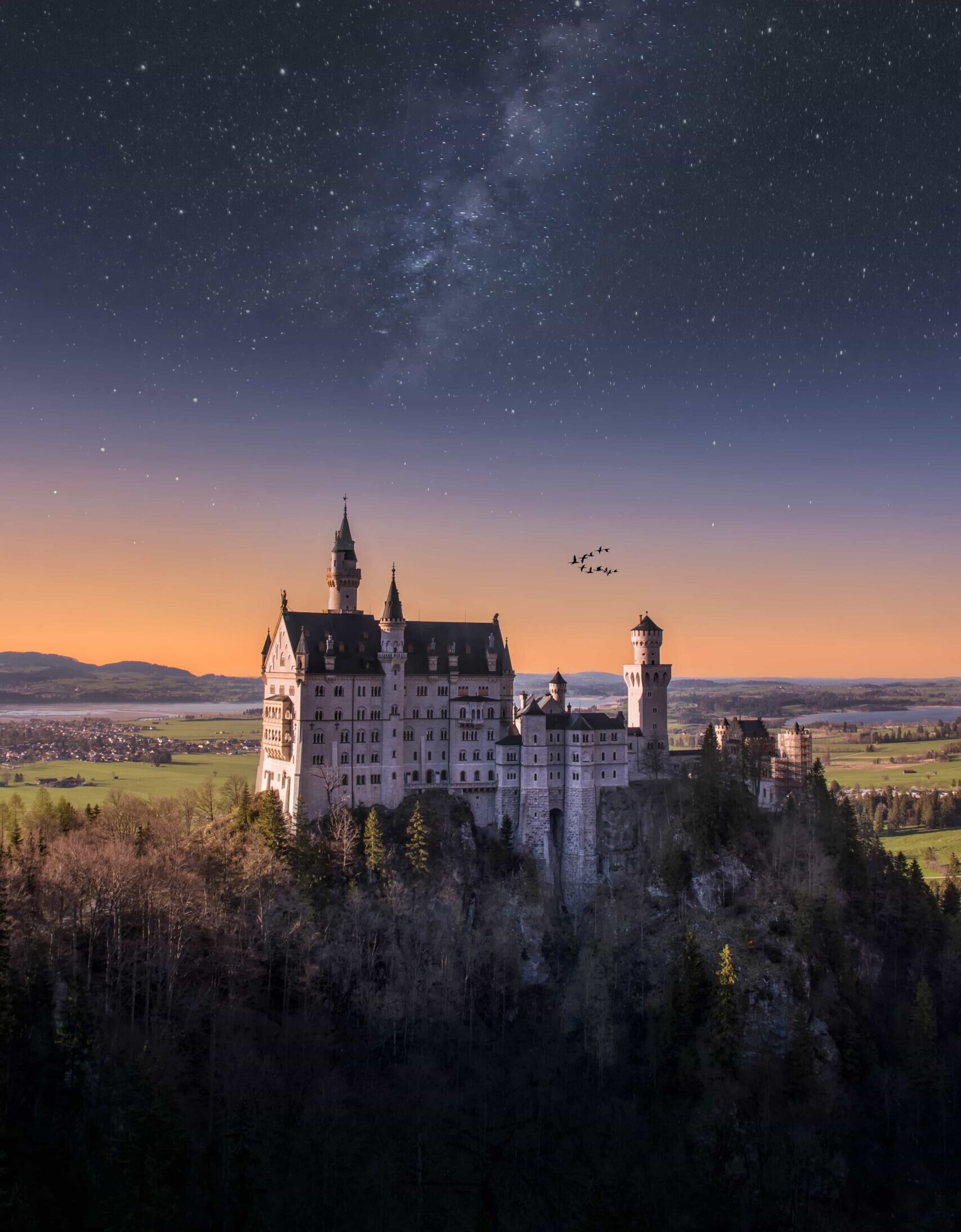
Neuschwanstein Castle
Neuschwanstein Castle was commissioned by King Ludwig II of Bavaria in honor of Richard Wagner. Ludwig opted to build the palace with his personal riches and substantial borrowing rather than with Bavarian state monies. Construction began in 1869 but was never finished. The castle was supposed to be the King’s private dwelling until his death in 1886. It was made available to the public shortly after his death. Over 61 million visitors have visited Neuschwanstein Castle since then.
Brandenburg Gate
The Brandenburg Gate is an ancient city gate and is a neoclassical landmark in Berlin and regarded as a symbol of the city’s history. It was erected on the site of a previous city gate that marked the beginning of the route from Berlin to Brandenburg a der Havel. The gate marked the entrance to Unter den Linden, a street lined with linden trees that led straight to the regal City Palace of the Prussian kings. Throughout its history, the Brandenburg Gate has been the location of key historical events, and it is now regarded not just as a symbol of Germany’s and Europe’s turbulent past, but also of European unity and peace. It is located in the western portion of Berlin’s Mitte district, at the intersection of Unter den Linden and Ebertstraße, just west of Pariser Platz.


Berlin Cathedral
The Berlin Cathedral is a massive German Evangelical church and dynasty mausoleum on Berlin’s Museum Island. Since the 1400s, many constructions have housed the church, which began as a castle chapel for the Berlin Palace. The listed structure is Germany’s largest Protestant church and one of Europe’s most prominent dynastic graves. The cathedral’s original interior, which was damaged during Allied bombing during WWII, was rebuilt by 2002. The cathedral is utilized for state ceremonies, concerts, and other events in addition to church services.
Heidelberg Palace
The remains of Heidelberg Castle are among the most significant Renaissance constructions north of the Alps. Since its destruction in the 17th and 18th centuries, the castle has only been partially reconstructed. It is placed 80 meters up the northern slope of the Königstuhl mountainside, dominating the view of the old town.
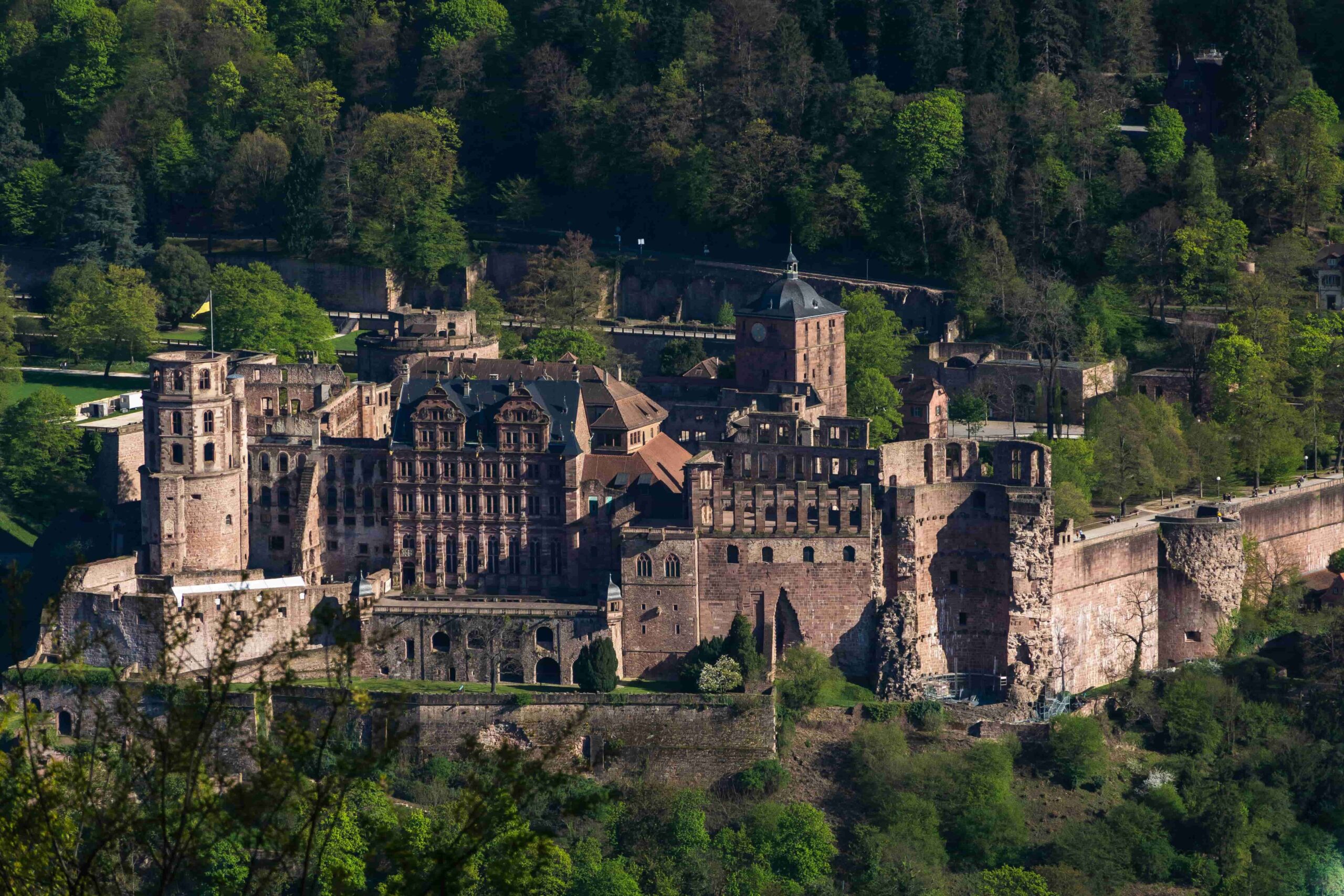

Rhine Gorge
The Rhine Gorge is a 65-kilometer stretch of the River Rhine between Koblenz and Bingen. It was inscribed on the UNESCO list of World Heritage Sites in 2002 for its unique mix of geological, historical, cultural, and industrial grounds. The gorge creates its own microclimate and serves as a gateway for species not seen elsewhere in the region.
7-day Itinerary in Germany
Day 1
Arrive in Munich
Begin your journey in Bavaria’s beautiful city, Munich. If you arrive at Munich Airport, the Munich Marienplatz Station is about 30 minutes away. You can simply start strolling to the city center after you arrive at the station and that is if you have arrived in a favorable time to start your exploration.
After arriving in Munich, make your way to the Old Town to begin your immersion in the magnificent architecture that this country has to offer. You can definitely sign up for a free walking tour of Old Town to see the medieval architecture and the modern neo-Gothic town hall with its bell tower, or you could do it yourself if you prefer to move at your own pace.

When you’re done with the Old Town tour, have lunch in one of the numerous classic gardens, particularly the lakefront one at Englischer Garten, an 18th-century park and the largest in Germany. In the summer, the town is buzzing with guests, and there is never a boring moment.
After you’ve had your fill, you can unwind by strolling through the English garden. Following that, you, visit St. Peter’s Church, the area’s oldest church with mixed architecture for diverse features, or Asamkirche (Asam Church), a Baroque-styled church.
Then, visit one (or more) of the town’s numerous museums to learn more about history, sculpture, and art. The Deutsches Museum is a must-see for everyone interested in science and technology. Glyptothek is primarily dedicated to ancient sculptures. There’s even an Egyptian Art Museum beneath the ground. Everyone will find something they enjoy!

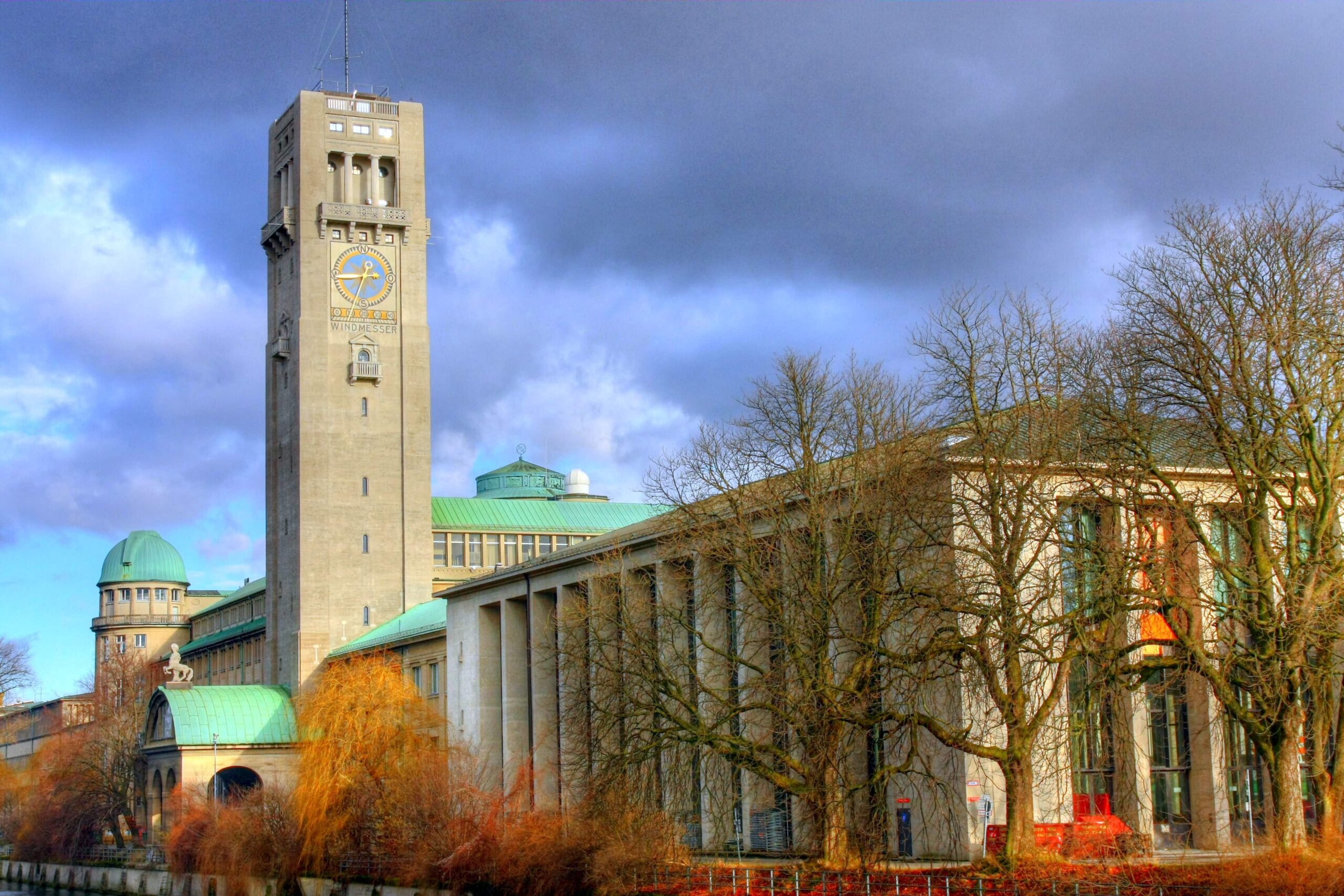
In the evening, you can head to the 200-year-old Victuals Market (Viktualienmarkt), which contains over 100 cuisine vendors as well as a beer garden. If you love cheese, there’s nowhere else to be. Munich even boasts a beer hall, the Hofbräuhaus, which is a massive three-story beer hall that dates back to the 16th century. You can conclude the day on a ‘high’ note! The cuisine is also fantastic, but expect to wait because this location is often busy.
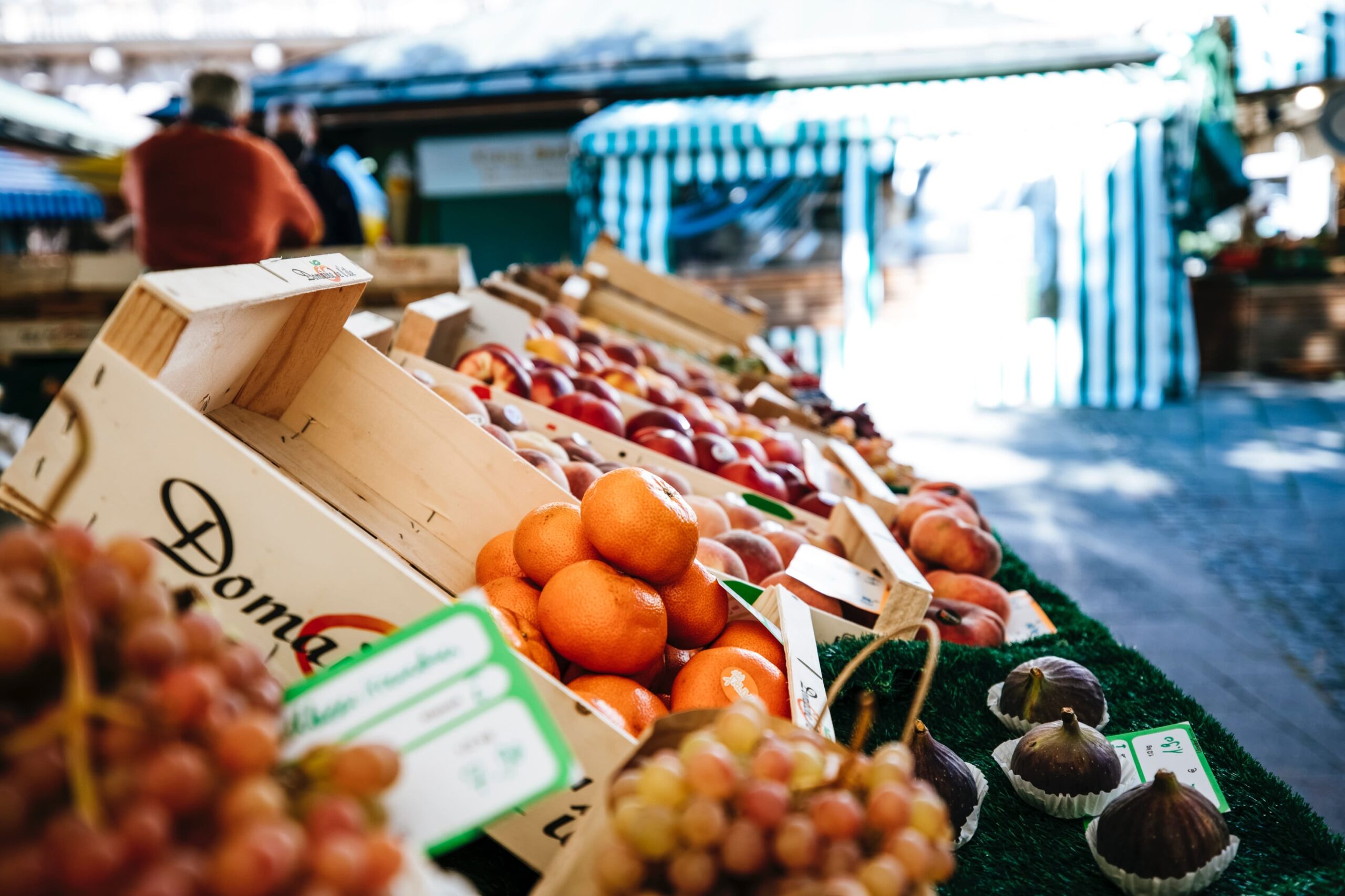
- Backpacker: The Tent Munich, MEININGER Hotel München City, Low Budget Hostel, MEININGER Hotel München Olympiapark
- Budget: ibis budget Muenchen Ost Messe, Tulip Inn München Messe, ibis Muenchen Parkstadt Schwabing
- Mid-range: Super 8 by Wyndham Munich City West, Leonardo Hotel Munich City East, the niu Fury
- Luxury: Hotel Augustin, Soulmade, Haus im Tal, Hotel Vier Jahreszeiten Kempinski München, BEYOND by Geisel, The Charles Hotel, a Rocco Forte Hotel
When it becomes dark, a foreign city may be twice as dangerous - especially if you don't understand the language and are unfamiliar with the area. However, there is no reason to be alarmed about walking home alone in the dark - there is just not enough crime recorded in Munich to warrant anxiety.
This section will be added shortly. Refer to the transportation block in the top section.
Day 2
A Day trip from Munich
After breakfast, begin the second day on a wonderful note. Neuschwanstein Castle is only 2 hours from Munich, so take a day trip to Füssen to tour King Ludwig II of Bavaria’s 19th-century mountaintop fairy tale castle.
If you haven’t had enough castles yet, another castle that you can see is roughly 3 to 4 hours distant from this Neuschwanstein. The Heidelberg Castle (Schloss Heidelberg) is really the remnants of a castle from the 16th century. It is set on a hill and is accessible through the mountain train (Bergbahn). It also houses the biggest wine barrel in the world.
Spend your evening in one of the Heidelberg’s charming cafés and feast your eyes on its beautiful architecture. Just like tourist attractions, there’s a café for every type of café lover, from comfortable to vintage, Instagrammable, patio, or futuristic.
When you’re done with the day, return to Munich and complete the day by heading to the markets again or by participating in one of Munich’s bar crawls to experience the city’s nightlife.
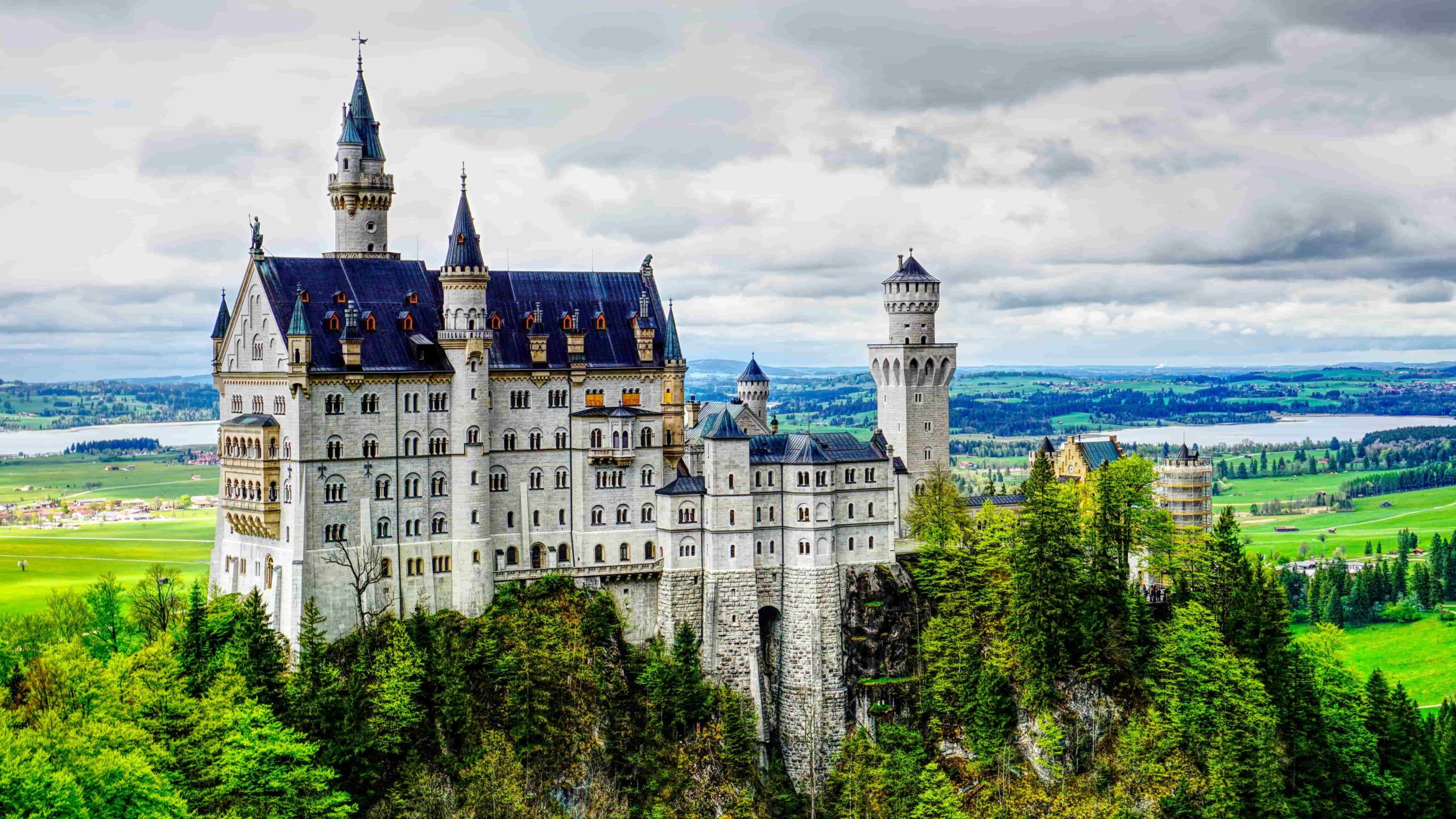
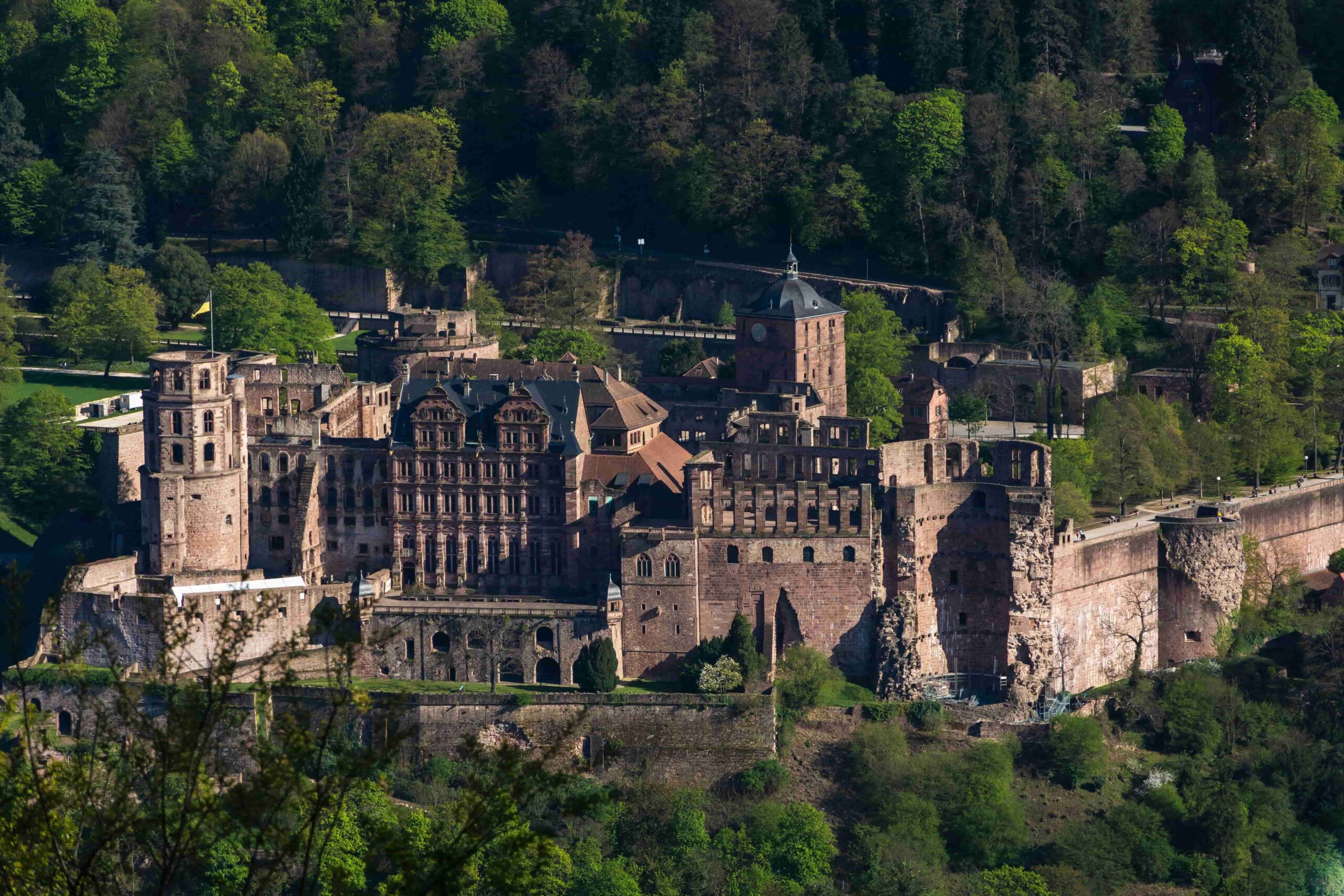


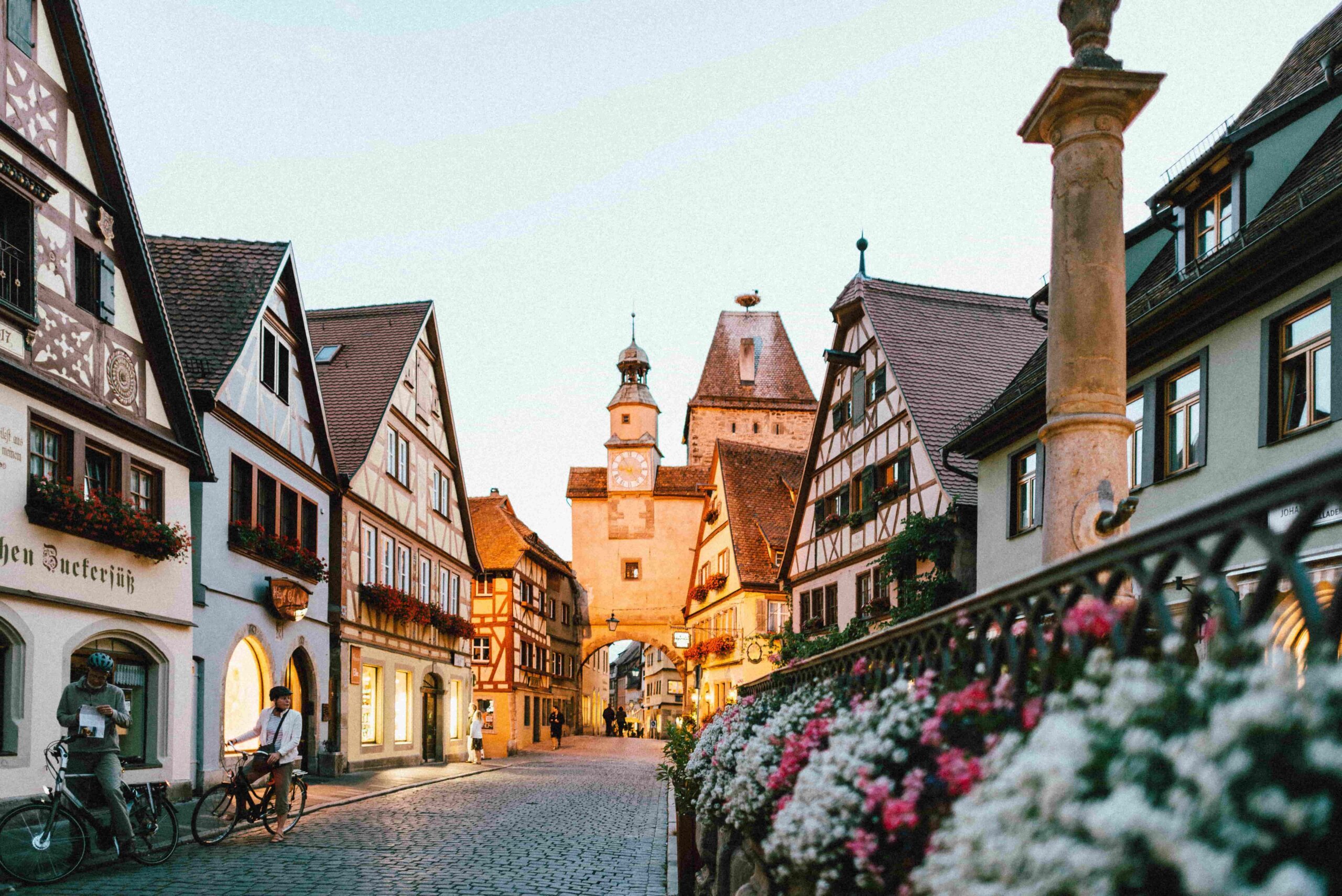
Day 3
Take the Romantische Straße
The Romantic Road is a 350km scenic path that takes you through adjacent towns like Augsburg, Würzburg, and Rothenburg. The road boasts mountain vistas and forests of Bavaria and Baden-Württemberg. Starting from, Füssen, 130km from Munich, and its iconic Castle Neuschwanstein the Alp until you eventually reach Würzburg. So, if you didn’t have a chance to tour the Neuschwanstein castle on the previous day, now is your time.
You can take the Romantic Road from Munich for around 3 hours to reach the charming village of Rothenburg, with its cobblestone lanes and timbered colorful buildings. So, if you do not have your own car, you can simply and inexpensively rent one in Germany.

Rothenburg ob der Tauber translates as “red stronghold above the Tauber River,” referring to the medieval town’s red-roofed homes and was an inspiration to several works, including Harry Potter and the Deathly Hallows and Willy Wonka and the Chocolate Factory.
The Criminal Museum allows visitors to see the torture equipment and procedures utilized in medieval times, which is a grim sight. You can also visit the imperial Rothenburg Castle after visiting the Roedertor Tower for a beautiful aerial perspective of the town. In the Castle Garden, you may unwind and spend a calm evening. Also, take the Night Watchman tour through the dark alleyways and poorly lighted trails with the Rothenburg Night Watchman for a one-of-a-kind experience.
- Backpacker:
- Budget:
- Mid-range:
- Luxury:
This section will be added shortly. Refer to the transportation block in the top section.
Day 4
The Black Forest
The Black Forest is Germany’s famed wooded and hilly area, an ideal family vacation location, complete with adventure and leisure opportunities, Gothic-style hamlets, and vineyards.
Visit Steinwasen Theme Park or, better still, Europa Park, Europe’s second biggest theme park featuring a variety of themed attractions and roller coasters. Both children and adults will enjoy themselves there!
You can also visit Triberg Waterfall, Germany’s tallest waterfall. The walk to the top provides various observation platforms from which to enjoy the vista. Also visit the Upper Middle Rhine Valley, often known as the Rhine Valley, to see the UNESCO World Heritage-listed Rhine Gorge. It is home to some of Germany’s top vineyards and is best visited in autumn when harvest season.


As an addition, or alternatively, you can head 2 hours to another UNESCO World Heritage site, Lake Constance, often known as Bodensee. This lake has four boundaries and a stunning view of the Alps! Reichenau, the smallest island on Lake Constance, is also a UNESCO World Heritage Site. It also features a monastery of the same name and chapels from the 9th century. From the island, take in the breathtaking view of the lake. There are several activities available near the lake. Take a leisurely boat or ferry trip, relax in a hot spa, or fly over the lake in a Zeppelin. Catch the sunset by the lake and then dine at one of the surrounding restaurants.

- Backpacker:
- Budget:
- Mid-range:
- Luxury:
This section will be added shortly.
This section will be added shortly. Refer to the transportation block in the top section.
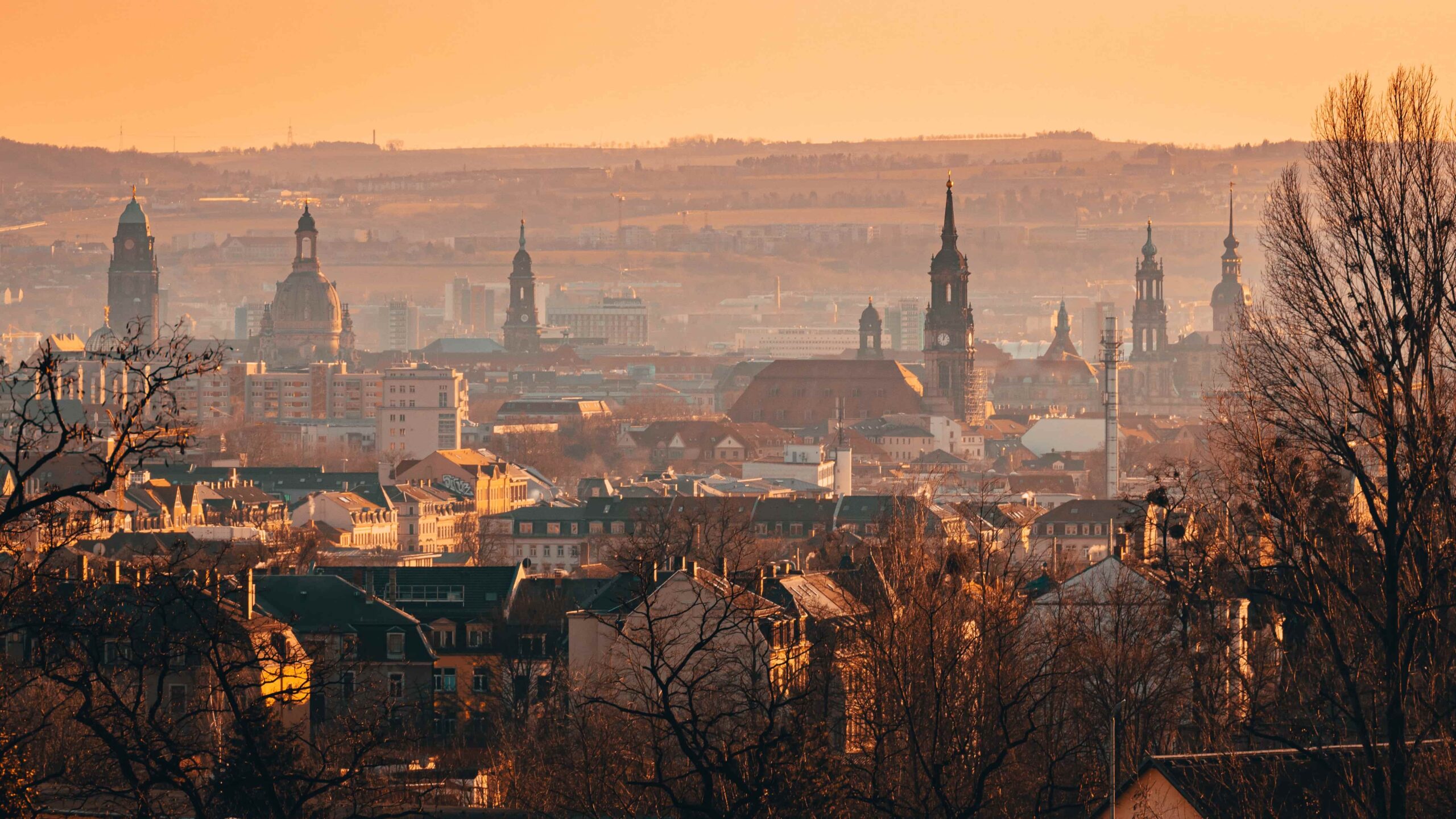
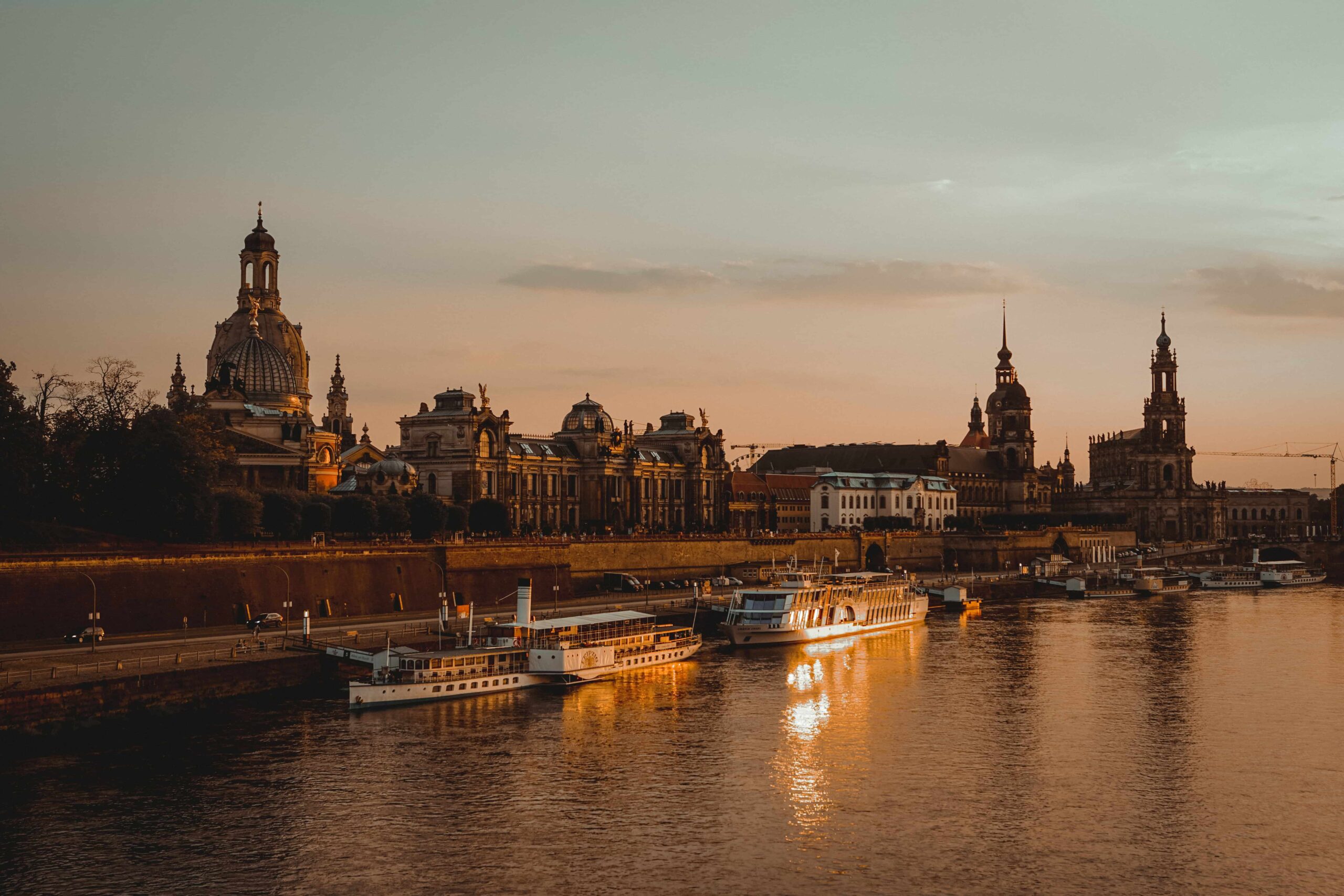
Day 5
Head to Dresden
After your breakfast, next up on your Germany itinerary is Dresden, situated on the banks of the Elbe River, some 6-7 hours from the Black Forest. Begin by visiting the Dresden Frauenkirche church, often known as the Lady Church. Here’s a brief history of the town’s most recognizable monument.
The old Romanesque-style 11th-century church was demolished and replaced with a bigger Baroque-styled church in the 18th century, but it was regrettably destroyed during World War II bombing of Dresden. The bones were left as a war monument for almost a decade. After Germany’s reunification, the church was reconstructed and finished in 2005. Because of its unusual high bell-shaped dome, it has become a sign of recognition for Dresden’s skyline.
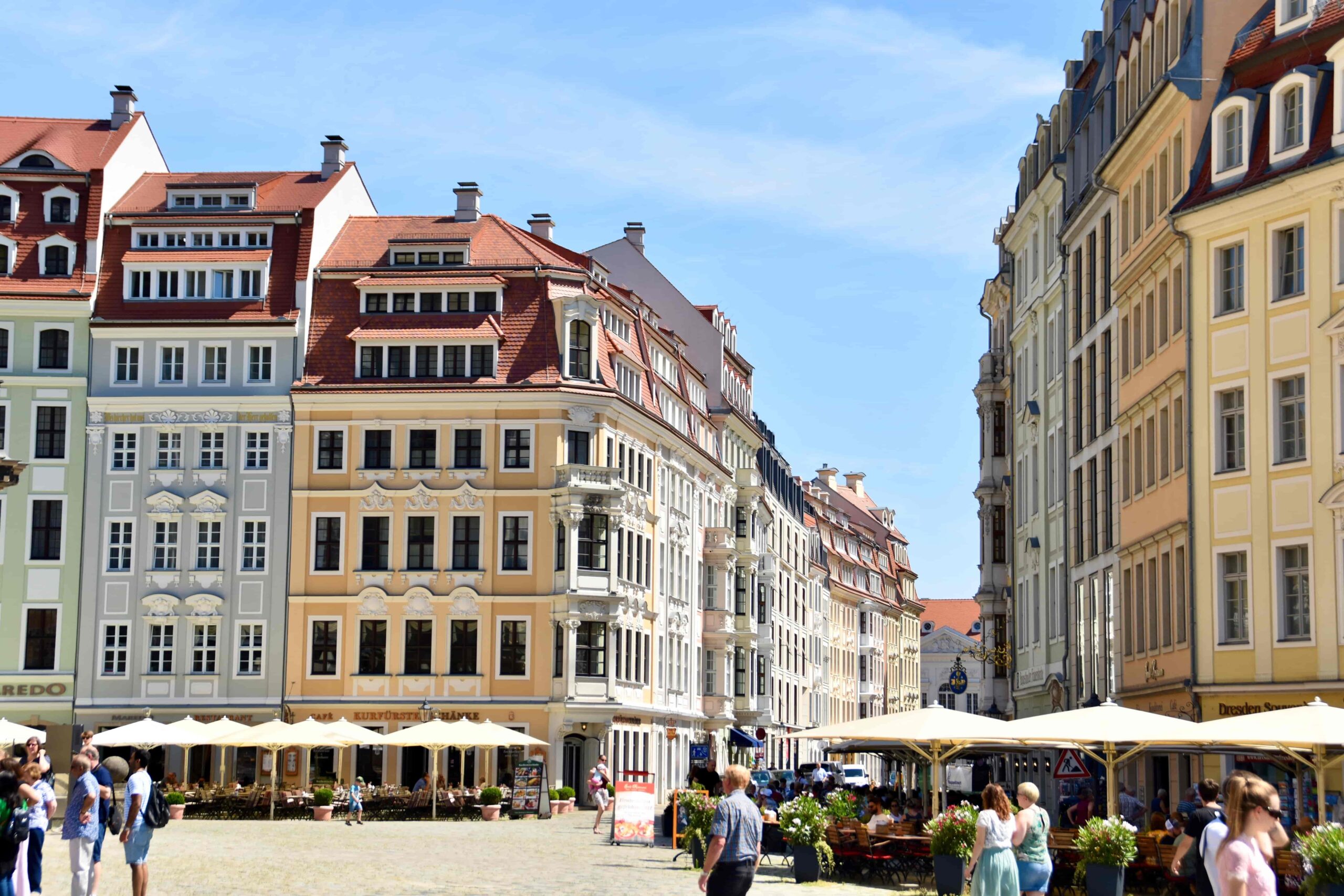
You can discover more about Dresden’s turbulent history by taking a city tour. But also check out the Green Vault (Grünes Gewölbe), where the royal money is kept. It is one of the most secure chambers in Europe. Dresden also has a lovely side, with several European-style cafés and bistros and a busy recreational area along the Elbe river’s banks.
- Backpacker:
- Budget:
- Mid-range:
- Luxury:
This section will be added shortly.
This section will be added shortly. Refer to the transportation block in the top section.
Day 6
Hamburg – The Old Meets the New
After lovely breakfast, take a train or drive from Dresden to Hamburg, which will take around 5 hours, and spend the day seeing this harbor city. Your exit from the country will be the next day from Berlin.
The gorgeous central avenue of Hamburg, which connects the Old and New Towns, is well worth seeing. When you’re done free strolling, begin scratching off some of the worthwhile attractions. If you enjoy chocolate then Chocoversum is your heaven! Stepping inside will transport you to Willy Wonka’s chocolate factory. Alternatively, if you’re not a chocolate person, you can go to Miniatur Wunderland, the world’s largest model train and small airport museum.
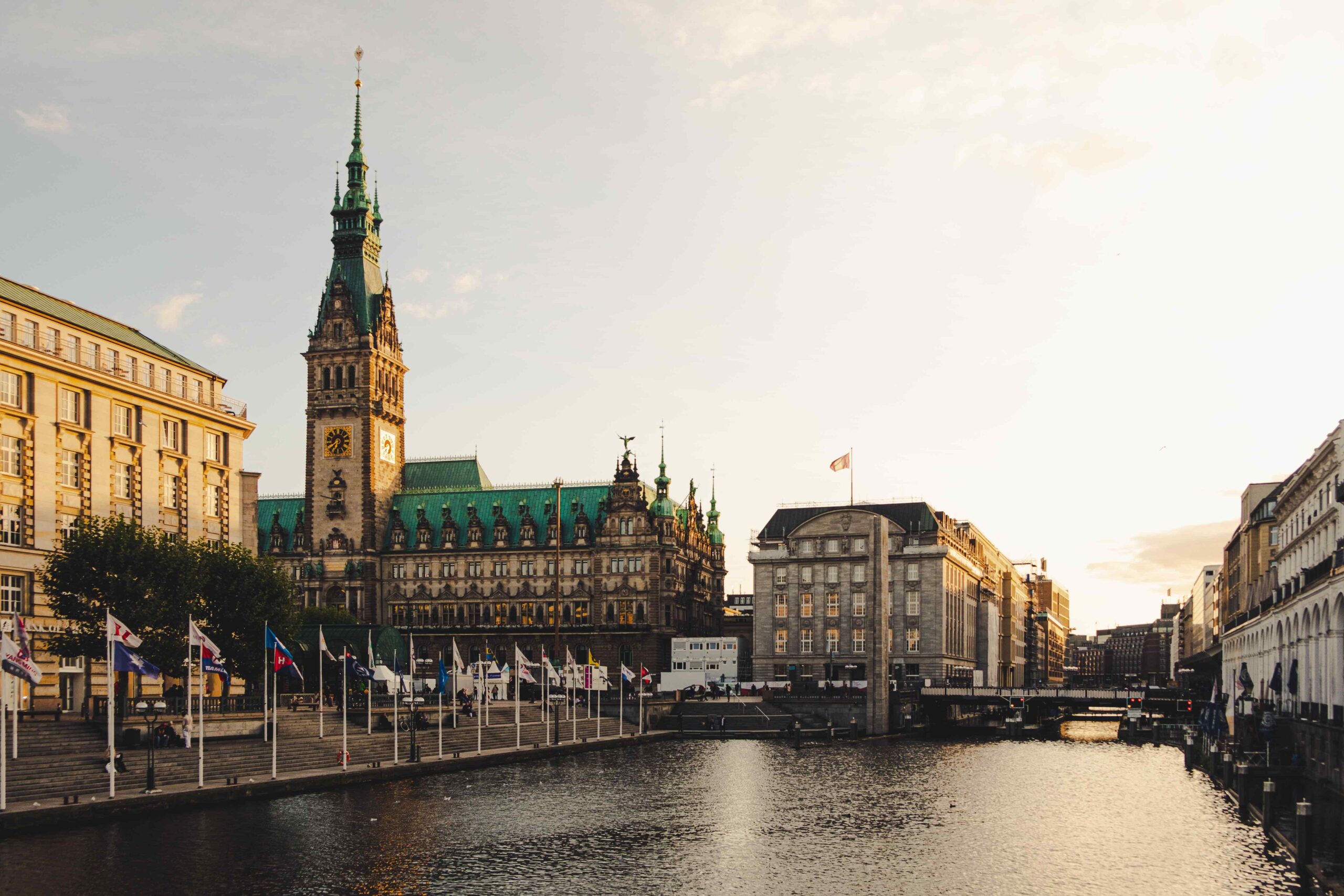

When you’re done, head to Hamburg Cathedral, and if you’re lucky, you might catch the Hamburg Dom Festival, which believe it or not, is held three times a year in the spring, summer, and winter. Next up, head to Alster Lake. Aside from the river, Hamburg boasts a lake in the city center called Lake Alster, where you may see swans delicately swimming across its waters.
You can also end the day by taking in the nightlife on Hamburg’s Reeperbahn, the city’s entertainment district. So, go out and experience the busy streets where the Beatles are said to have performed, visit the clubs, or join a nightclub crawl.

- Backpacker:
- Budget:
- Mid-range:
- Luxury:
This section will be added shortly.
This section will be added shortly. Refer to the transportation block in the top section.
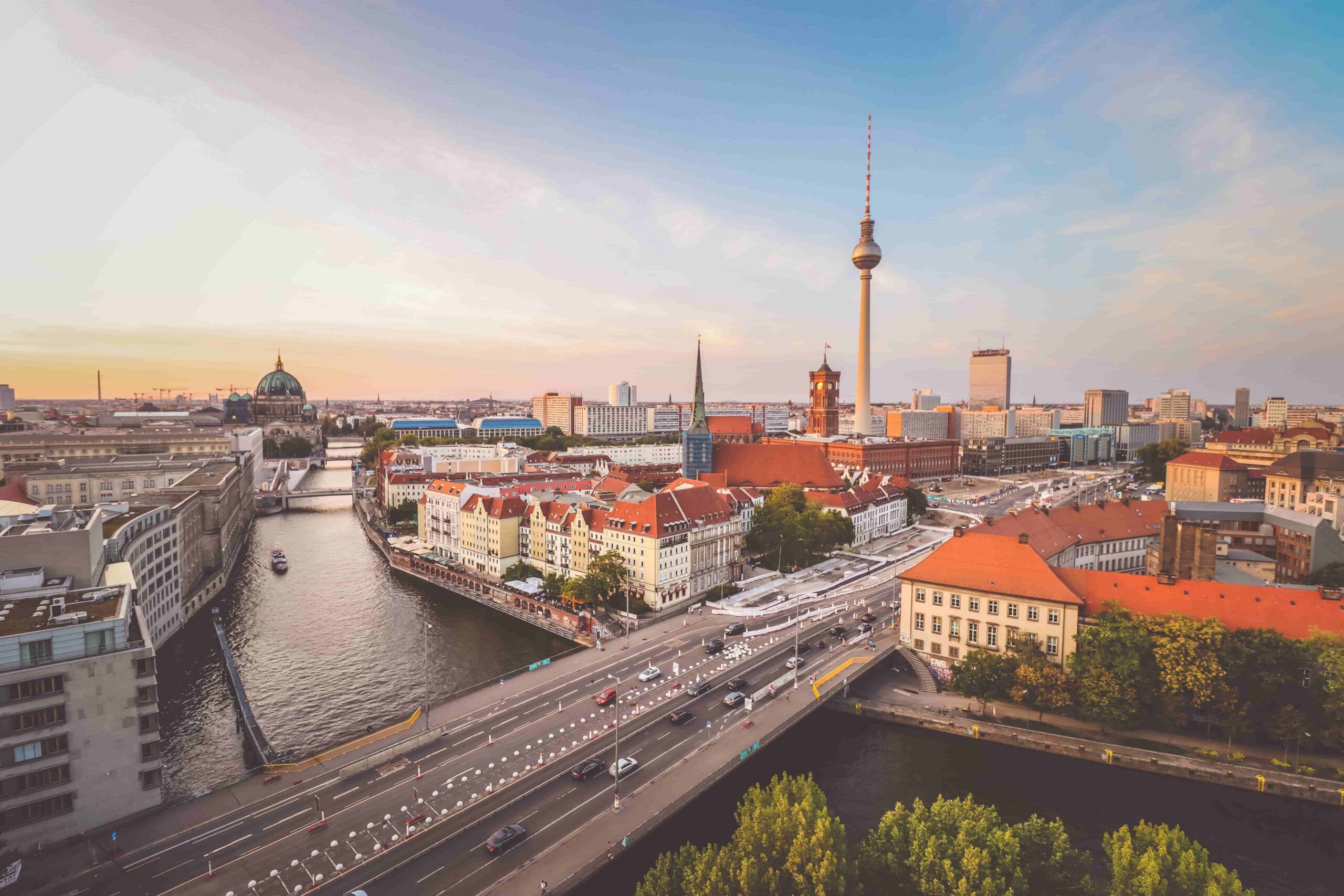

Day 7
Final Stop in Berlin
After having a hearty breakfast, maybe at the banks of Hamburg’s river, head to the train station, or drive to Berlin. There are hourly trains from Hamburg to Berlin that take 90 minutes to an hour to reach your last destination on your Germany plan.
Begin your day in Berlin on a high note, visit the Reichstag dome for an overhead perspective of the city. The glass dome constructed over the Reichstag is this monument. The Reichstag, commonly known as the Imperial Diet or the Parliament, is the most prominent and famous historical edifice of the German empire. It is located in Berlin’s government district. A boat trip past the Reichstag is also available.

Then, for free, enjoy a walking tour of the Brandenburg Gate and the Holocaust Memorial. During the Cold War, the Brandenburg Gate was a favorite meeting place for politicians. It is the sole old city gate that has survived and serves as a symbol of reunified Germany following the collapse of the Berlin Wall.
The Holocaust Memorial, a somber remembrance of the dead, with hundreds of concrete slabs atop grey pillars commemorating the lost lives.


After that, you can visit the East Side Gallery, an open-air gallery located on the longest surviving section of the Berlin Wall, to explore the murals and artworks. It has been designated as a historical landmark. Following this creative masterpiece, visit Museum Island, which is home to five world-class museums. It is a World Heritage site that offers insights into several fields. The Pergamom houses ancient architecture, The Altes Museum houses Greek and Roman art, The Bode Museum houses Byzantine empire works, The Alte Nationalgalerie displays 19th century views, and The Neues Museum houses archaeological relics.
On your final night in Germany, you can take a leisurely late-night stroll around Berlin’s largest park and most iconic monument, Tiergarten. Or you can may go to the cool Kreuzberg neighborhood and relax at a café while drinking chilled drinks at one of the many fast-food establishments and eateries. This area also contains clubs that are open till the early hours of the morning.
If feasible, spend more than a day in Berlin, due to the diversity of attractions you could possibly see.
- Backpacker:
- Budget:
- Mid-range:
- Luxury:
This section will be added shortly.
This section will be added shortly. Refer to the transportation block in the top section.
Day 8
Departure
Now that you’ve a good portion of Germany, you’ll know which ones you want to spend more time investigating on your future visits or which ones you missed on this one.
Head to Berlin’s Brandenburg Airport, and bid Germany goodbye!
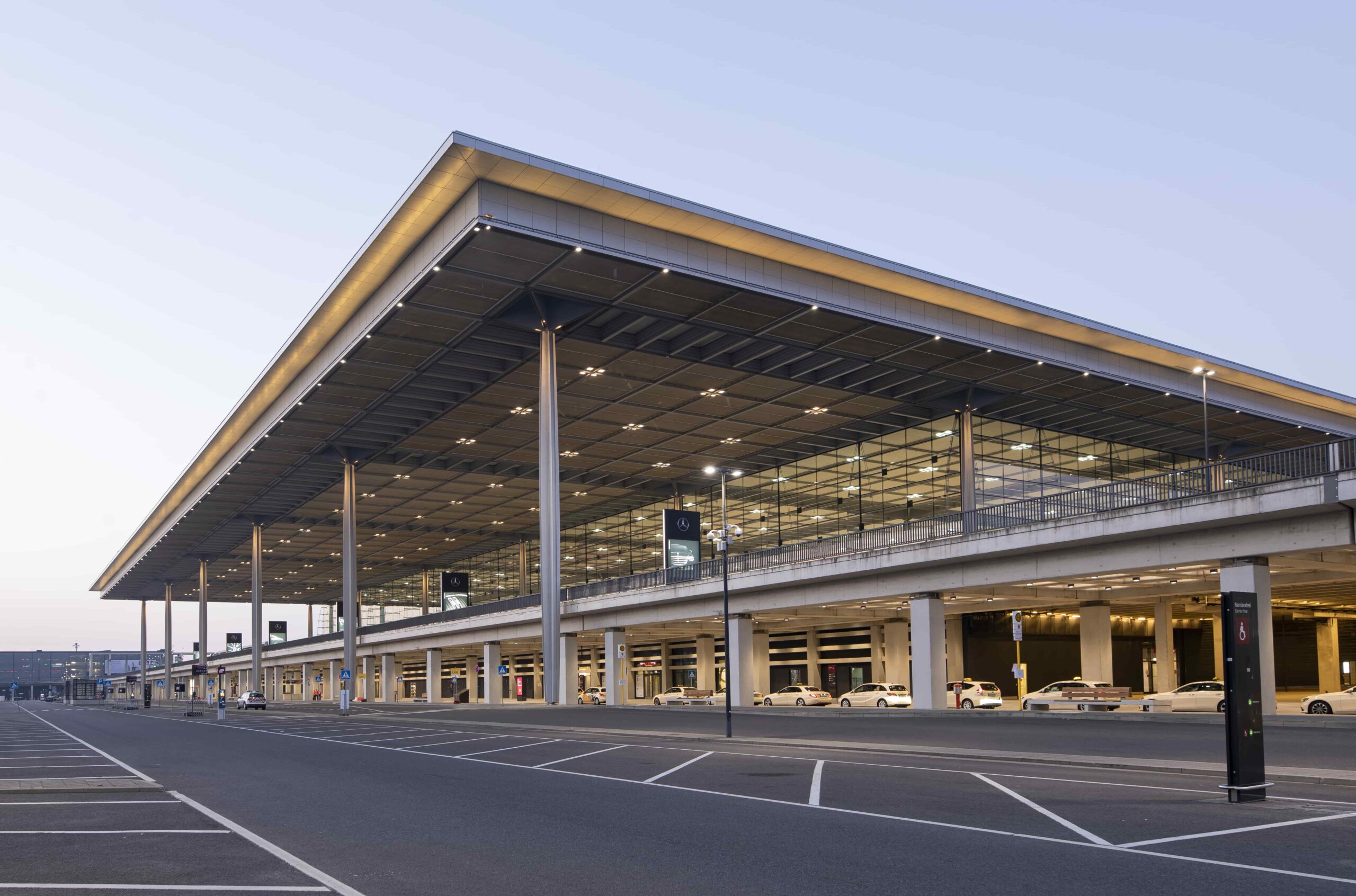
The Most Popular Food in Germany
Traditional meat-and-potato dishes are popular in German eateries. Sauce and vegetables are typically given on the side with dishes. If you go to a more contemporary restaurant, the cuisine will be more inspired by neighboring European nations, but you’ll always receive a great bratwurst and a cold beer. German cuisine is immensely diverse, drawing inspiration from cooking traditions such as Polish, Turkish, and Jewish, among others.

Bratwurst
This is the most ubiquitous German sausage, and it can be found almost anywhere. It’s usually served on a bun with mustard and sauerkraut. It’s a terrific low-cost choice that can be easily obtained from street sellers in most major cities. It’s an excellent late-night snack or quick lunch choice on the run.

Döner Kebab
Döner kebab is a famous street snack in Germany, thanks to Turkish immigrants, specifically Kadir Nurman, who presented it on his booth in 1972. It’s a popular, inexpensive lunch that’s flavorful but inexpensive. The dish is made out of shredded beef with sauce and chopped vegetables wrapped in a warm and delicious pita.
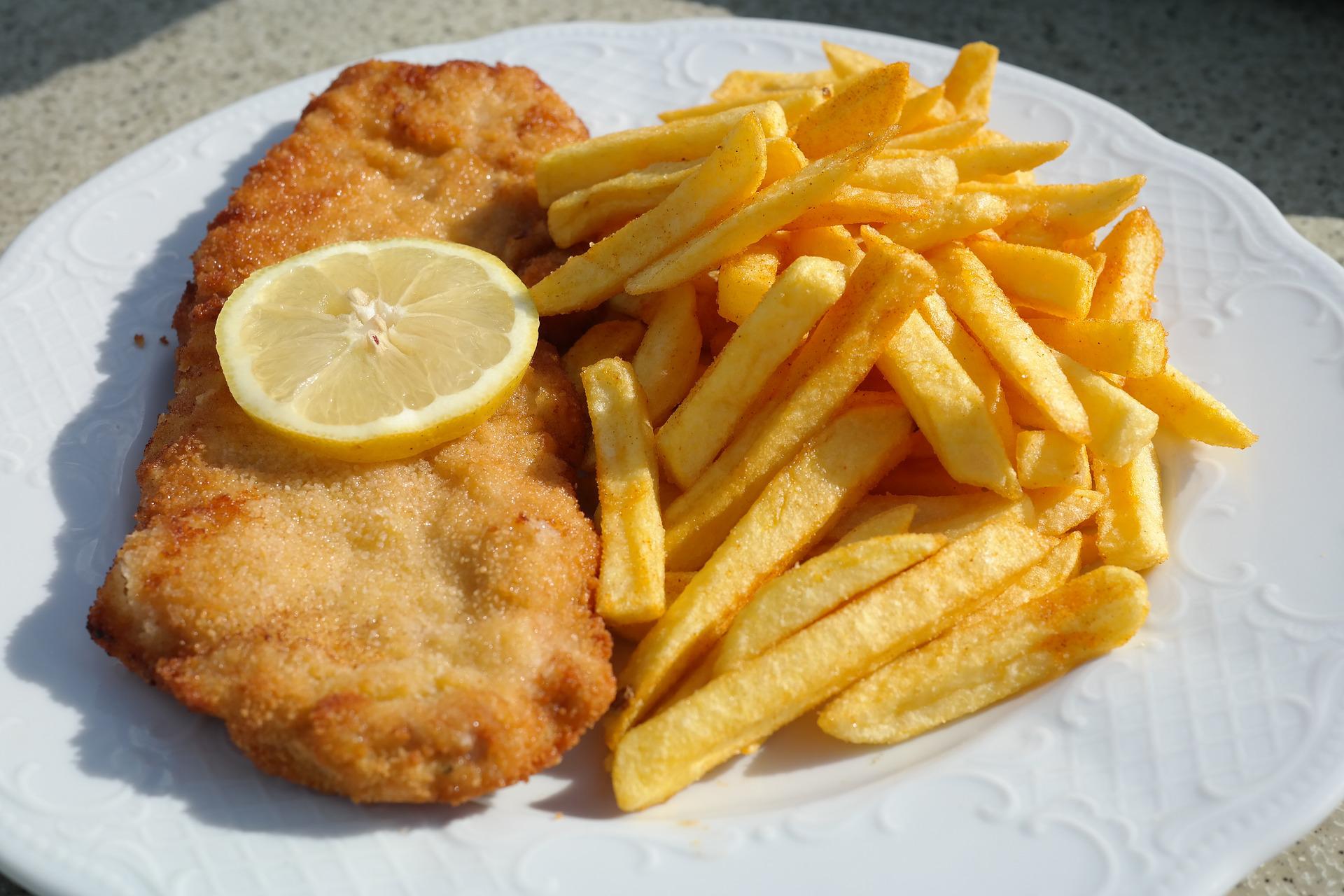
Schnitzel
Tenderizing a piece of meat (such as chicken, beef, veal, or hog) and then coating it in egg, flour, and breadcrumbs before frying it in oil is how a Schnitzel is created. The Schnitzel, which is comparable to a French escalope, originated in Austria.
This meal is characteristic of German food offered in pubs, restaurants, and fast-food establishments. Schnitzel with fries is a popular and filling option.

Sauerbraten
Sauerbraten is a German pot roast that literally means “sour roast.” The sour component alludes to the beef being pickled in a sweet and sour gravy-like sauce before being gently roasted in a dish. Meats are often veal, beef, or pig that has been marinated for days or even weeks. You can eat it throughout Germany as well as German speaking countries.

Currywurst
It is not a food that Germans eat at home, but rather something that is consumed ‘on the move.’ This platter of diced up sausages, chips, and a spicy ketchup sauce is an extremely popular German cuisine, especially after a few pilsners.
What's the Travel Budget for Germany?
Flights
- Flights start at roughly $60 from nearby countries. Tickets however on average cost around $700 and can cost way more depending on which class and from which country you depart from.
Accommodation
- Nomad Backpacking style travelers can expect to spend around $200 for a week
- Budget travelers can expect to spend around $460 for a week
- Mid-range travelers can expect to spend around $670 for a week
- Luxury travelers can expect to spend around $1,000 for a week
Food Budget (Three meals and drinks)
- Nomad Backpacking style travelers can expect to spend around $22 per person per day
- Budget travelers can expect to pay around $30 per person per day
- Mid-range travelers on average would cost $35 to $50 per person per day
- Luxury travelers can expect to pay around $60 to $110 per person per day
Overall Budget Styles (Not including Flights, Tours, Transportation, or Car Rental)
- Nomad Backpacking style travelers can expect to spend roughly $360 for a week
- Budget travelers can expect to spend close to $710 for one person for a week
- Mid-range travelers can expect to spend approximately $1,100 for one person for a week
- Luxury travelers can expect to spend around $1,750 for one person for a week
Flights
- Flights start at roughly $60 from nearby countries. Tickets however on average cost around $700 and can cost way more depending on which class and from which country you depart from.
Accommodation
- Nomad Backpacking style travelers can expect to spend around $200 for a week
- Budget travelers can expect to spend around $460 for a week
- Mid-range travelers can expect to spend around $670 for a week
- Luxury travelers can expect to spend around $1,000 for a week
Food Budget (Three meals and drinks)
- Nomad Backpacking style travelers can expect to spend around $22 per person per day
- Budget travelers can expect to pay around $30 per person per day
- Mid-range travelers on average would cost $35 to $50 per person per day
- Luxury travelers can expect to pay around $60 to $110 per person per day
Overall Budget Styles (Not including Flights, Tours, Transportation, or Car Rental)
- Nomad Backpacking style travelers can expect to spend roughly $360 for a week
- Budget travelers can expect to spend close to $710 for one person for a week
- Mid-range travelers can expect to spend approximately $1,100 for one person for a week
- Luxury travelers can expect to spend around $1,750 for one person for a week
Flights
- Flights start at roughly $60 from nearby countries. Tickets however on average cost around $700 and can cost way more depending on which class and from which country you depart from.
Accommodation
- Nomad Backpacking style travelers can expect to spend around $200 for a week
- Budget travelers can expect to spend around $460 for a week
- Mid-range travelers can expect to spend around $670 for a week
- Luxury travelers can expect to spend around $1,000 for a week
Food Budget (Three meals and drinks)
- Nomad Backpacking style travelers can expect to spend around $22 per person per day
- Budget travelers can expect to pay around $30 per person per day
- Mid-range travelers on average would cost $35 to $50 per person per day
- Luxury travelers can expect to pay around $60 to $110 per person per day
Overall Budget Styles (Not including Flights, Tours, Transportation, or Car Rental)
- Nomad Backpacking style travelers can expect to spend roughly $360 for a week
- Budget travelers can expect to spend close to $710 for one person for a week
- Mid-range travelers can expect to spend approximately $1,100 for one person for a week
- Luxury travelers can expect to spend around $1,750 for one person for a week
Flights
- Flights start at roughly $60 from nearby countries. Tickets however on average cost around $700 and can cost way more depending on which class and from which country you depart from.
Accommodation
- Nomad Backpacking style travelers can expect to spend around $200 for a week
- Budget travelers can expect to spend around $460 for a week
- Mid-range travelers can expect to spend around $670 for a week
- Luxury travelers can expect to spend around $1,000 for a week
Food Budget (Three meals and drinks)
- Nomad Backpacking style travelers can expect to spend around $22 per person per day
- Budget travelers can expect to pay around $30 per person per day
- Mid-range travelers on average would cost $35 to $50 per person per day
- Luxury travelers can expect to pay around $60 to $110 per person per day
Overall Budget Styles (Not including Flights, Tours, Transportation, or Car Rental)
- Nomad Backpacking style travelers can expect to spend roughly $360 for a week
- Budget travelers can expect to spend close to $710 for one person for a week
- Mid-range travelers can expect to spend approximately $1,100 for one person for a week
- Luxury travelers can expect to spend around $1,750 for one person for a week
If you want to know what to pack, read this list below:
- This is a Casual European country that can get extremely cold or too rainy and windy sometimes, dress accordingly
- Raincoat or Light Waterproof Jacket
- Hiking Boots or Sturdy Sneakers (Shoes You Don’t Mind Getting Wet)
- Sunscreen
- Insect Protection – Repellent and Clothing
- Sunglasses and Sun Hat
- Water Shoes
- Beach Towels/Sarong
- Dry Bag
- Money Belt or Cross Bag
- Portable Medical Kit
- Flashlight or Headlamp
- Copies of your passport.
- Get all the needed vaccinations before traveling
- A power bank is a must in any travel.
- Always have some cash with you just in case there are no ATMs and if you are dealing with a business that solely accepts cash
- Get yourself an adapter for your gadgets
- 1 toothbrush
- 1 tube of toothpaste
- 1 razor
- 1 package of dental floss
- 1 small bottle of shampoo
- 1 small bottle of shower gel
- 1 towel
- Deodorant
- Band-Aids
- Hydrocortisone cream
- Antibacterial cream
- Earplugs
- Tylenol
- Hand sanitizer (germs = sick = bad holiday)
- A key or combination lock
- Zip-lock bags
- Plastic bags (great for laundry)
- Universal charger/adaptor
- LifeStraw (A water bottle with a purifier)
- 1 dry shampoo spray & talc powder
- 1 hairbrush
- Makeup you use
- Hairbands & hair clips
- Feminine hygiene products
Clothing For Boys
- 1 pair of jeans or khaki pants
- 1 pair of shorts
- 1 bathing suit
- 5 T-shirts
- 1 long-sleeved T-shirt
- 1 pair of flip-flops
- 1 pair of sneakers
- 6 pairs of socks
- 5 pairs of boxer shorts
Clothing For Girls
- 1 swimsuit
- 1 sarong
- 1 pair of stretchy jeans
- 1 pair of leggings
- 2-3 long-sleeve tops
- 2-3 T-shirts
- 3-4 spaghetti tops
- 1 light cardigan
Want to plan your own trip, here are some of the best resources that can help you
- Skyscanner – They search small websites and budget airlines that larger search sites tend to miss. They are hands down the number one place to start.
- Momondo – This is another favorite flight search engine because they search such a wide variety of sites and airlines. Always check here too.
- Booking.com – The best all-around booking site that constantly provides the most affordable and lowest rates. They have the widest selection of budget accommodation.
- Couchsurfing – This website allows you to stay on people’s couches or spare rooms for free. It’s a great way to save money while meeting locals who can tell you the ins and outs of their city. The site also lists events you can attend to meet people (even if you’re not staying with someone).
- Intrepid Travel – If you want to do group tours, go with Intrepid. They offer good small group tours that use local operators and leave a small environmental footprint.
- Grassroots Volunteering – For volunteering, Grassroots Volunteering compiles a list of good local volunteer organizations that keep the money within the community.
- Get Your Guide – Get Your Guide is a huge online marketplace for tours and excursions. They have tons of tour options available in cities all around the world, including everything from cooking classes, walking tours, street art lessons, and more! It has the world’s largest collection of things to do with more than 30,000 activities in 7500 destinations.
- SafetyWing – Safety Wing offers convenient and affordable plans tailored to digital nomads and long-term travelers. They have cheap monthly plans, great customer service, and an easy-to-use claims process that makes it perfect for those on the road.
- Trip Advisor: Check the reviews and then book your accommodation. TripAdvisor is where you go when you want to compare prices with multiple accommodation providers.
- VRBO: is the main search engine to use when you are looking for a home or apartment rental. It can sometimes be cheaper than hotels and it is the best way to stay in areas that offer a more local feel.
- Hostelworld: With one of the largest databases of hostels in the world, Hostelworld is the go-to site when you are looking for budget accommodation.
- Rome 2 Rio: If you want to see how to get somewhere by plane, train, bus, ferry, or car Rome2Rio lays it all out for you as well as related costs.
- World Nomads Insurance: When traveling you should always have travel insurance. We have found the best bang for your buck is by far World Nomads.
Final Thoughts on Germany
With its ancient structures, punctual and serious people, magnificent and distinct landmarks, great hospitality, exciting festivals and dances, and a breathtaking environment, Germany has a refined and rich heritage that can be observed across the country going back to when the Romans ruled. A fantastic option for anybody searching for a great region of Europe to discover. Germany is breathtakingly beautiful, with incredible national treasures, wildlife, and gorgeous scenery. Would you go to Germany?
Have you been to Germany? Please share your thoughts in the comments section below.